C. -C. Jay Kuo
Lawrence
Deep-JGAC: End-to-End Deep Joint Geometry and Attribute Compression for Dense Colored Point Clouds
Feb 25, 2025Abstract:Colored point cloud becomes a fundamental representation in the realm of 3D vision. Effective Point Cloud Compression (PCC) is urgently needed due to huge amount of data. In this paper, we propose an end-to-end Deep Joint Geometry and Attribute point cloud Compression (Deep-JGAC) framework for dense colored point clouds, which exploits the correlation between the geometry and attribute for high compression efficiency. Firstly, we propose a flexible Deep-JGAC framework, where the geometry and attribute sub-encoders are compatible to either learning or non-learning based geometry and attribute encoders. Secondly, we propose an attribute-assisted deep geometry encoder that enhances the geometry latent representation with the help of attribute, where the geometry decoding remains unchanged. Moreover, Attribute Information Fusion Module (AIFM) is proposed to fuse attribute information in geometry coding. Thirdly, to solve the mismatch between the point cloud geometry and attribute caused by the geometry compression distortion, we present an optimized re-colorization module to attach the attribute to the geometrically distorted point cloud for attribute coding. It enhances the colorization and lowers the computational complexity. Extensive experimental results demonstrate that in terms of the geometry quality metric D1-PSNR, the proposed Deep-JGAC achieves an average of 82.96%, 36.46%, 41.72%, and 31.16% bit-rate reductions as compared to the state-of-the-art G-PCC, V-PCC, GRASP, and PCGCv2, respectively. In terms of perceptual joint quality metric MS-GraphSIM, the proposed Deep-JGAC achieves an average of 48.72%, 14.67%, and 57.14% bit-rate reductions compared to the G-PCC, V-PCC, and IT-DL-PCC, respectively. The encoding/decoding time costs are also reduced by 94.29%/24.70%, and 96.75%/91.02% on average as compared with the V-PCC and IT-DL-PCC.
Green Video Camouflaged Object Detection
Jan 19, 2025Abstract:Camouflaged object detection (COD) aims to distinguish hidden objects embedded in an environment highly similar to the object. Conventional video-based COD (VCOD) methods explicitly extract motion cues or employ complex deep learning networks to handle the temporal information, which is limited by high complexity and unstable performance. In this work, we propose a green VCOD method named GreenVCOD. Built upon a green ICOD method, GreenVCOD uses long- and short-term temporal neighborhoods (TN) to capture joint spatial/temporal context information for decision refinement. Experimental results show that GreenVCOD offers competitive performance compared to state-of-the-art VCOD benchmarks.
RadHop-Net: A Lightweight Radiomics-to-Error Regression for False Positive Reduction In MRI Prostate Cancer Detection
Jan 03, 2025



Abstract:Clinically significant prostate cancer (csPCa) is a leading cause of cancer death in men, yet it has a high survival rate if diagnosed early. Bi-parametric MRI (bpMRI) reading has become a prominent screening test for csPCa. However, this process has a high false positive (FP) rate, incurring higher diagnostic costs and patient discomfort. This paper introduces RadHop-Net, a novel and lightweight CNN for FP reduction. The pipeline consists of two stages: Stage 1 employs data driven radiomics to extract candidate ROIs. In contrast, Stage 2 expands the receptive field about each ROI using RadHop-Net to compensate for the predicted error from Stage 1. Moreover, a novel loss function for regression problems is introduced to balance the influence between FPs and true positives (TPs). RadHop-Net is trained in a radiomics-to-error manner, thus decoupling from the common voxel-to-label approach. The proposed Stage 2 improves the average precision (AP) in lesion detection from 0.407 to 0.468 in the publicly available pi-cai dataset, also maintaining a significantly smaller model size than the state-of-the-art.
Efficient Human-Object-Interaction (EHOI) Detection via Interaction Label Coding and Conditional Decision
Aug 13, 2024Abstract:Human-Object Interaction (HOI) detection is a fundamental task in image understanding. While deep-learning-based HOI methods provide high performance in terms of mean Average Precision (mAP), they are computationally expensive and opaque in training and inference processes. An Efficient HOI (EHOI) detector is proposed in this work to strike a good balance between detection performance, inference complexity, and mathematical transparency. EHOI is a two-stage method. In the first stage, it leverages a frozen object detector to localize the objects and extract various features as intermediate outputs. In the second stage, the first-stage outputs predict the interaction type using the XGBoost classifier. Our contributions include the application of error correction codes (ECCs) to encode rare interaction cases, which reduces the model size and the complexity of the XGBoost classifier in the second stage. Additionally, we provide a mathematical formulation of the relabeling and decision-making process. Apart from the architecture, we present qualitative results to explain the functionalities of the feedforward modules. Experimental results demonstrate the advantages of ECC-coded interaction labels and the excellent balance of detection performance and complexity of the proposed EHOI method.
Word Embedding Dimension Reduction via Weakly-Supervised Feature Selection
Jul 17, 2024



Abstract:As a fundamental task in natural language processing, word embedding converts each word into a representation in a vector space. A challenge with word embedding is that as the vocabulary grows, the vector space's dimension increases and it can lead to a vast model size. Storing and processing word vectors are resource-demanding, especially for mobile edge-devices applications. This paper explores word embedding dimension reduction. To balance computational costs and performance, we propose an efficient and effective weakly-supervised feature selection method, named WordFS. It has two variants, each utilizing novel criteria for feature selection. Experiments conducted on various tasks (e.g., word and sentence similarity and binary and multi-class classification) indicate that the proposed WordFS model outperforms other dimension reduction methods at lower computational costs.
GSBIQA: Green Saliency-guided Blind Image Quality Assessment Method
Jul 08, 2024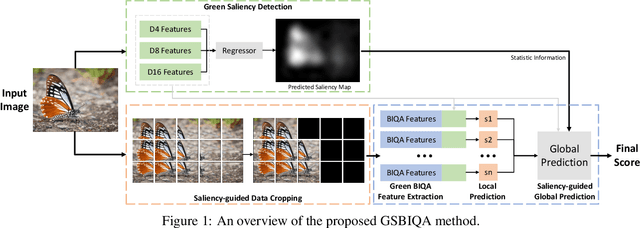

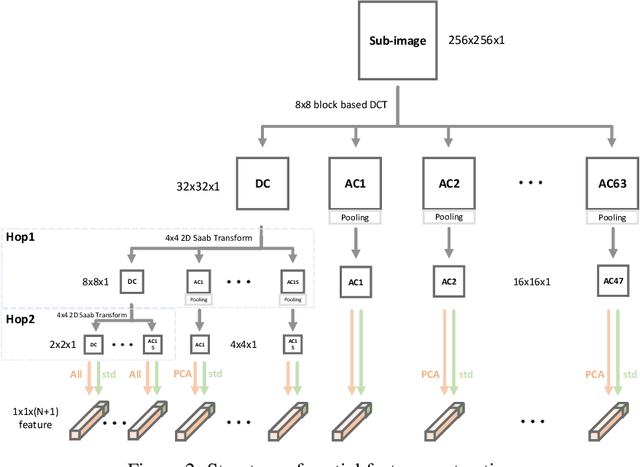

Abstract:Blind Image Quality Assessment (BIQA) is an essential task that estimates the perceptual quality of images without reference. While many BIQA methods employ deep neural networks (DNNs) and incorporate saliency detectors to enhance performance, their large model sizes limit deployment on resource-constrained devices. To address this challenge, we introduce a novel and non-deep-learning BIQA method with a lightweight saliency detection module, called Green Saliency-guided Blind Image Quality Assessment (GSBIQA). It is characterized by its minimal model size, reduced computational demands, and robust performance. Experimental results show that the performance of GSBIQA is comparable with state-of-the-art DL-based methods with significantly lower resource requirements.
GreenCOD: A Green Camouflaged Object Detection Method
May 25, 2024



Abstract:We introduce GreenCOD, a green method for detecting camouflaged objects, distinct in its avoidance of backpropagation techniques. GreenCOD leverages gradient boosting and deep features extracted from pre-trained Deep Neural Networks (DNNs). Traditional camouflaged object detection (COD) approaches often rely on complex deep neural network architectures, seeking performance improvements through backpropagation-based fine-tuning. However, such methods are typically computationally demanding and exhibit only marginal performance variations across different models. This raises the question of whether effective training can be achieved without backpropagation. Addressing this, our work proposes a new paradigm that utilizes gradient boosting for COD. This approach significantly simplifies the model design, resulting in a system that requires fewer parameters and operations and maintains high performance compared to state-of-the-art deep learning models. Remarkably, our models are trained without backpropagation and achieve the best performance with fewer than 20G Multiply-Accumulate Operations (MACs). This new, more efficient paradigm opens avenues for further exploration in green, backpropagation-free model training.
GreenSaliency: A Lightweight and Efficient Image Saliency Detection Method
Mar 30, 2024Abstract:Image saliency detection is crucial in understanding human gaze patterns from visual stimuli. The escalating demand for research in image saliency detection is driven by the growing necessity to incorporate such techniques into various computer vision tasks and to understand human visual systems. Many existing image saliency detection methods rely on deep neural networks (DNNs) to achieve good performance. However, the high computational complexity associated with these approaches impedes their integration with other modules or deployment on resource-constrained platforms, such as mobile devices. To address this need, we propose a novel image saliency detection method named GreenSaliency, which has a small model size, minimal carbon footprint, and low computational complexity. GreenSaliency can be a competitive alternative to the existing deep-learning-based (DL-based) image saliency detection methods with limited computation resources. GreenSaliency comprises two primary steps: 1) multi-layer hybrid feature extraction and 2) multi-path saliency prediction. Experimental results demonstrate that GreenSaliency achieves comparable performance to the state-of-the-art DL-based methods while possessing a considerably smaller model size and significantly reduced computational complexity.
PCa-RadHop: A Transparent and Lightweight Feed-forward Method for Clinically Significant Prostate Cancer Segmentation
Mar 24, 2024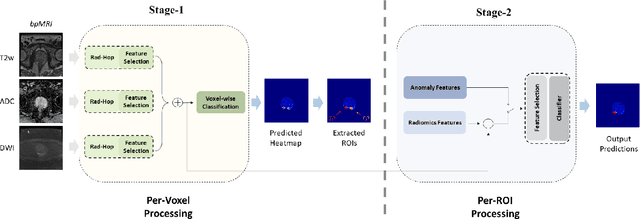


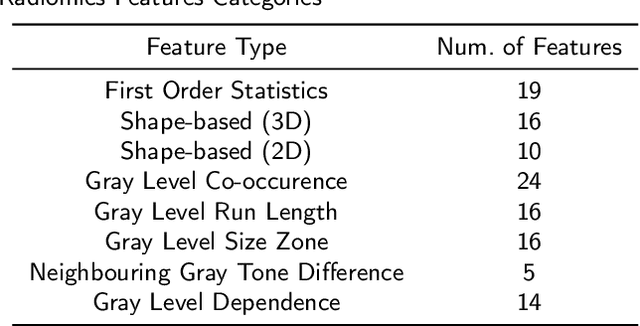
Abstract:Prostate Cancer is one of the most frequently occurring cancers in men, with a low survival rate if not early diagnosed. PI-RADS reading has a high false positive rate, thus increasing the diagnostic incurred costs and patient discomfort. Deep learning (DL) models achieve a high segmentation performance, although require a large model size and complexity. Also, DL models lack of feature interpretability and are perceived as ``black-boxes" in the medical field. PCa-RadHop pipeline is proposed in this work, aiming to provide a more transparent feature extraction process using a linear model. It adopts the recently introduced Green Learning (GL) paradigm, which offers a small model size and low complexity. PCa-RadHop consists of two stages: Stage-1 extracts data-driven radiomics features from the bi-parametric Magnetic Resonance Imaging (bp-MRI) input and predicts an initial heatmap. To reduce the false positive rate, a subsequent stage-2 is introduced to refine the predictions by including more contextual information and radiomics features from each already detected Region of Interest (ROI). Experiments on the largest publicly available dataset, PI-CAI, show a competitive performance standing of the proposed method among other deep DL models, achieving an area under the curve (AUC) of 0.807 among a cohort of 1,000 patients. Moreover, PCa-RadHop maintains orders of magnitude smaller model size and complexity.
PSHop: A Lightweight Feed-Forward Method for 3D Prostate Gland Segmentation
Mar 24, 2024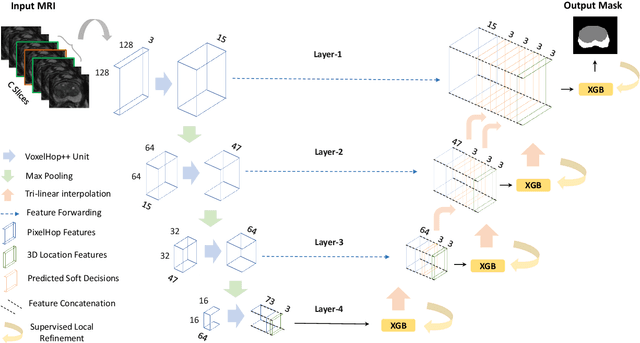
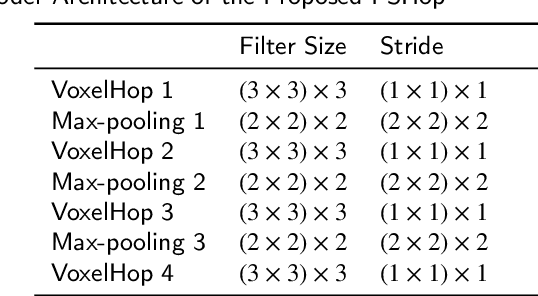
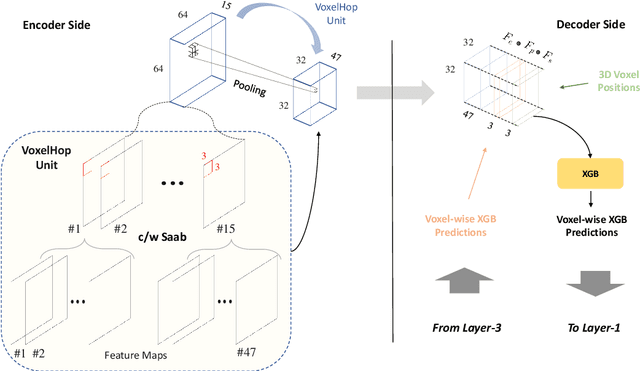

Abstract:Automatic prostate segmentation is an important step in computer-aided diagnosis of prostate cancer and treatment planning. Existing methods of prostate segmentation are based on deep learning models which have a large size and lack of transparency which is essential for physicians. In this paper, a new data-driven 3D prostate segmentation method on MRI is proposed, named PSHop. Different from deep learning based methods, the core methodology of PSHop is a feed-forward encoder-decoder system based on successive subspace learning (SSL). It consists of two modules: 1) encoder: fine to coarse unsupervised representation learning with cascaded VoxelHop units, 2) decoder: coarse to fine segmentation prediction with voxel-wise classification and local refinement. Experiments are conducted on the publicly available ISBI-2013 dataset, as well as on a larger private one. Experimental analysis shows that our proposed PSHop is effective, robust and lightweight in the tasks of prostate gland and zonal segmentation, achieving a Dice Similarity Coefficient (DSC) of 0.873 for the gland segmentation task. PSHop achieves a competitive performance comparatively to other deep learning methods, while keeping the model size and inference complexity an order of magnitude smaller.
 Add to Chrome
Add to Chrome Add to Firefox
Add to Firefox Add to Edge
Add to Edge